Public Sphere and Misinformation in the U.S. Election: Trump’s Audience and Populism Indicators in the COVID-19 Context
Abstract
:1. Introduction
- O1.
- To find out the causes of the fall in the electorate’s confidence in Donald Trump after the U.S. elections.
- O2.
- To find out, from the opinion polls, the electorate’s opinion on Donald Trump’s populist discourse based on the delegitimization of the electoral results.
- O3.
- To understand the change of attitude of the Republican electorate following the events related to the attack on the Capitol.
2. Background
2.1. Leadership and Cyber Populism’s Influence at Election Time
2.2. Audience Activism against Trump’s Infodemic in Times of Crisis
3. Materials and Methods
3.1. Research Questions and Hypotheses
- Q1.
- What have been the causes of the loss of confidence in Trump manifested by a part of the American electorate after the U.S. elections?
- Q2.
- What is the electorate’s opinion of Trump’s populist strategy in the post-election phase?
- Q3.
- How have Trump’s fraud speech and the incidents of the Capitol attack influenced the change of attitudes of the U.S. electorate?
- MH.
- Populism emerges as a communicative and discursive strategy in the context of management systems based on capitalism and globalization.
- SH1.
- Political populism, when perceived as such, generates rejection and distrust in the electorate.
- SH2.
- The attack on the Capitol and Donald Trump’s reaction after learning the polling data generated a change in the attitude of the Republican electorate.
3.2. Methodology
- -
- Wave 78 of the American Trends Panel (Pew Research’s American Trend Panel 2020): Developed by Pew Research Center, it is an online survey panel that, through a national and random sampling, seeks to understand the attitudes of the American electorate after the 2020 presidential election. The survey was conducted on 12–17 November 2020, among 11,818 U.S. adults, including 10,399 U.S. citizens who reported voting in that election. The survey, which had a margin of sampling error of ±1.6 percentage points, was weighted to be representative of the U.S. adult population by gender, race, ethnicity, political affiliation, education and other categories
- -
- Wave 80 of the American Trends Panel (Pew Research’s American Trend Panel 2021): The Pew Research Center conducted this new survey to examine the public’s reactions to the aftermath of the 2020 presidential election, including Americans’ views of Biden as president-elect, also for ratings on the Capitol Hill assault. The survey, conducted 8–12 January 2021, consults 5360 U.S. adults recruited through random sampling with weighting, as above, to ensure representativeness of the U.S. adult population based on the variables: gender, race, ethnicity, political affiliation, education and other categories. The margin of error for this survey is ±1.9 percentage points.
4. Results
5. Discussion and Conclusions
Author Contributions
Funding
Institutional Review Board Statement
Informed Consent Statement
Data Availability Statement
Conflicts of Interest
References
- Ahmed, Mirza Ashfaq, Suleman Aziz Lodhi, and Zahoor Ahmad. 2017. Political Brand Equity Model: The Integration of Political Brands in Voter Choice. Journal of Political Marketing 16: 147–79. [Google Scholar] [CrossRef]
- Aleixandre-Benavent, Rafael, Lurdes Castelló-Cogollos, and Juan-Carlos Valderrama-Zurián. 2020. Información y comunicación durante los primeros meses de Covid-19. Infodemia, desinformación y papel de los profesionales de la información. El Profesional de la Información 29: e290408. [Google Scholar] [CrossRef]
- Allcott, Hunt, and Matthew Gentzkow. 2017. Social media and fake news in the 2016 election. Journal of Economic Perspectives 31: 211–36. [Google Scholar] [CrossRef] [Green Version]
- Almansa Pérez, Rosa. 2019. El populismo de extrema derecha en los Estados Unidos de la era Trump: De la democracia “sin rostro” a la reacción identitaria. Anales de la Cátedra Francisco Suárez 53: 157–81. [Google Scholar] [CrossRef]
- Balz, Dan, Scott Clement, and Emily Guskin. 2021. Biden Wins by Approval for Handling of Transition but Persistent GOP Skepticism on Issues Will Cloud the Opening of His Presidency, Post ABC Polls Finds. The Washington Post. Available online: https://www.washingtonpost.com/politics/poll-biden-trump-republicans/2021/01/16/5e41c9ba-575b-11eb-a08b-f1381ef3d207_story.html (accessed on 18 April 2021).
- Baym, Geoffrey. 2010. From Cronkite to Colbert: The Evolution of Broadcast News. Boulder: Paradigm. [Google Scholar]
- Bennett, W. Lance, and Steven Livingston. 2018. The disinformation order: Disruptive communication and the decline of democratic institutions. European Journal of Communication 33: 122–39. [Google Scholar] [CrossRef]
- Bennett, W. Lance, and Barbara Pfetsch. 2018. Rethinking political communication in a time of disrupted public spheres. Journal of Communication 68: 243–53. [Google Scholar] [CrossRef]
- Berger, Arthur Asa. 2017. Marketing and American Consumer Culture. New York: Springer. [Google Scholar]
- Bevelander, Pieter, and Ruth Wodak. 2019. Europe at the Crossroads: Confronting Populist, Nationalist and Global Challenges. Lund: Nordic Academic Press. [Google Scholar]
- Block, Elena, and Ralph Negrine. 2017. The Populist Communication Style: Toward a critical framework. International Journal of Communication 11: 178–97. [Google Scholar]
- Bracciale, Roberta, and Antonio Martella. 2017. Define the populist political communication style: The case of Italian political leaders on Twitter. Information, Communication & Society 20: 1310–29. [Google Scholar]
- Campos-Domínguez, Eva. 2017. Twitter y la comunicación política. El Profesional de la Información 26: 785–85. [Google Scholar] [CrossRef] [Green Version]
- Chadwick, Lauren, and Rafa Cereceda. 2020. La Cloroquina e Hidroxicloroquina Contra el Covid-19 ¿Una Esperanza? Euronews. Available online: https://es.euronews.com/2020/03/24/empiezan-los-ensayos-clinicos-con-cloroquina-contra-el-covid-19-una-esperanza (accessed on 7 April 2021).
- Corasaniti, Epstein Nick, J. Reid, and Jim Rutenberg. 2020. The Times Called Officials in Every State: No Evidence of Voter Fraud. New York Times. Available online: https://www.nytimes.com/2020/11/10/us/politics/voting-fraud.html (accessed on 25 February 2021).
- Cox, Michael. 2018. Understanding the Global Rise of Populism. LSE !deas. Available online: http://www.lse.ac.uk/ideas/Assets/Documents/updates/LSE-IDEAS-Understanding-Global-Rise-of-Populism.pdf (accessed on 3 March 2021).
- De las Heras Pedrosa, Carlos, Paniagua Rojano, Francisco Javier, Carmen Jambrino Maldonado, and Patricia Iglesias Sánchez. 2017. La imagen de los candidatos en las elecciones presidenciales de los Estados Unidos. Revista Latina de Comunicación Social 72: 975–97. [Google Scholar]
- El Español. 2020. Trump y la teoría de la conspiración: El 70% de los votantes republicanos cree que hubo fraude electoral. Available online: https://www.elespanol.com/mundo/america/20201112/trump-teoria-conspiracion-votantes-republicanos-fraude-electoral/535197626_0.html (accessed on 7 January 2021).
- Enli, Gunn. 2017. New media and politics. Annals of the International Communication Association 41: 220–27. [Google Scholar] [CrossRef] [Green Version]
- European Comission. 2018. Fake News and Disinformation Online. Flash Eurobarometer 464. Available online: http://ec.europa.eu/commfrontoffice/publicopinion/index (accessed on 25 March 2021).
- Fuchs, Christian. 2017. Donald Trump: A critical theory perspective on authoritarian capitalism. TripleC: Communication, Capitalism & Critique 15: 1–72. [Google Scholar]
- Gallup Poll. 2021. Available online: https://news.gallup.com/poll/328637/last-trump-job-approval-average-record-low.aspx (accessed on 24 March 2021).
- Gerbaudo, Paolo. 2018. Social media and populism: An elective affinity? Media, Culture & Society 40: 745–53. [Google Scholar]
- Graham, Todd, Marcel Broersma, Karin Hazelhoff, and Guido van’t Haar. 2013. Between broadcasting political messages and interacting with voters: The use of Twitter during the 2010 UK general election campaign. Information, Communication & Society 16: 692–716. [Google Scholar]
- Heidi, Larson J. 2020. Blocking information on Covid-19 can fuel the spread of misinformation. Nature 580: 306. [Google Scholar]
- Jiménez-Marín, Gloria, Rodrigo Elías Zambrano, Araceli Galiano-Coronil, and Luis BayardoTobar-Pesantez. 2021. Brand management from social marketing and happiness management binomial of in the age of Industry 4.0. Journal of Legal, Ethical and Regulatory Issues 24: 1–10. [Google Scholar]
- Kaiser, Brittany. 2020. I Blew the Whistle on Cambridge Analytica—Four Years Later, Facebook still Hasn’t Learnt Its Lesson. The Independent. Available online: https://www.independent.co.uk/voices/us-election-trump-cambridge analytica-facebook-fake-news-brexit-vote-leave-a9304421.html (accessed on 27 February 2021).
- Kissas, Angelos. 2019. Performative and ideological populism: The case of charismatic leaders on Twitter. Discourse & Society 31: 268–84. [Google Scholar]
- Lee, Sangwon, and Michael A. Xenos. 2019. Social distraction? Social media use and political knowledge in two US Presidential elections. Computers in Human Behavior 90: 18–25. [Google Scholar] [CrossRef]
- López Meri, Amparo. 2016. Twitter-retórica para captar votos en campaña electoral. El caso de las elecciones de Cataluña de 2015. Comunicación y Hombre 12: 97–118. [Google Scholar] [CrossRef]
- MacAllister, Ian. 2007. The personalization of Politics. In Oxford Handbook of Political Behavior, 1st ed. Edited by J. Dalton and Russell Hans-Dieter Kinglemann. Oxford: Oxford University Press. [Google Scholar]
- Milner, M. Rayan, and Whitney Phillips. 2016. Dark Magic: The memes that made Donald Trump’s victory. In US Election Analysis 2016: Media, Voters and the Campaign, 1st ed. Edited by Darren Lilleker, Daniel Jackson, Einar Thorsen and Anastasia Veneti. Poole: Centre for the Study of Journalism, pp. 84–85. [Google Scholar]
- Moffitt, Benjamin, and Simon Tormey. 2014. Rethinking populism: Politics, mediatisation, and political style. Political Studies 62: 381–97. [Google Scholar] [CrossRef]
- Montoya, Peter, and Tim Vandehey. 2009. The Brand Called You. Create a Personal Branding That Wins Attention and Grows Your Business. London: McGraw-Hill. [Google Scholar]
- Mounk, Yascha. 2018. The People vs. Democracy. Why Our Freedom Is in Danger and How to Save It. Cambridge: Harvard University Press. [Google Scholar]
- Neudert, Lisa Maria, and Nahema Marchal. 2019. Polarisation and the Use of Technology in Political Campaigns and Communication. European Parliamentary Research—Service Scientific Foresight Unit (STOA). Available online: https://doi.org/10.2861/167110 (accessed on 6 January 2021).
- Ott, Brian L. 2017. The age of Twitter: Donald J. Trump and the politics of debasement. Critical Studies in Media Communication 34: 59–68. [Google Scholar] [CrossRef]
- Pasitselska, Olga, and Christian Baden. 2019. Who are ‘the people’? Uses of empty signifiers in propagandistic news discourse. Journal of Language and Politics 19: 666–90. [Google Scholar] [CrossRef]
- Pérez Ortega, Andrés. 2014. Marca Personal para Dummies. Barcelona: PAPF. [Google Scholar]
- Pérez-Curiel, Choncha, and Ricardo Domínguez-García. 2021. Discurso político contra la democracia. Populismo, sesgo y falacia de Trump tras las elecciones de EEUU (3-N). Cultura, Lenguaje y Representación 25: 35–49. [Google Scholar]
- Pérez-Curiel, Concha, and Pilar Limón-Naharro. 2019. Political influencers. A study of Donald Trump’s personal brand on Twitter and its impact on the media and users. Communication & Society 32: 57–75. [Google Scholar]
- Pérez-Curiel, Concha, and Ana María Velasco Molpeceres. 2020. Impacto del discurso político en la difusión de bulos sobre Covid-19. Influencia de la desinformación en públicos y medios. Revista Latina de Comunicación Social 78: 65–97. [Google Scholar] [CrossRef]
- Persyli, Nathaniel, and Joshua A. Tucker. 2020. Social Media and Democracy: The State of the Field, Prospects for Reform. New York: Cambridge University Press. [Google Scholar]
- Pew Research’s American Trend Panel. 2020. Available online: https://www.pewresearch.org/politics/2020/11/20/sharp-divisions-on-vote-counts-as-biden-gets-high-marks-for-his-post-election-conduct/ (accessed on 10 April 2021).
- Pew Research’s American Trend Panel. 2021. Available online: https://www.pewresearch.org/politics/2021/01/15/biden-begins-presidency-with-positive-ratings-trump-departs-with-lowest-ever-job-mark/ (accessed on 10 April 2021).
- Pich, Christopher, and Bruce I. Newman. 2020. Evolution of Political Branding: Typologies, Diverse Settings and Future Research. Journal of Political Marketing 19: 3–14. [Google Scholar] [CrossRef]
- Plantic, Diana, Hrvoje Ratkic, and Branka Suput. 2017. Comparative analysis of mar-keting communication strategy on social networks: Case study of presidential candidates Donald Trump and Hillary Clinton. Paper presented at 20th International Scientific Conference on Economic and Social Development, Prague, Czech Republic, April 27–28. [Google Scholar]
- Ramírez Nárdiz, Alfredo. 2020. Aproximación al pensamiento político de Donald Trump: ¿es el presidente de Estados Unidos populista? Revista Española de Ciencia Política 52: 59–83. [Google Scholar] [CrossRef]
- Román-San-Miguel, Aránzazu, Nuria Sánchez-Gey-Valenzuela, and Rodrigo Elías Zambrano. 2020. Fake news during the COVID-19 State of Alarm. Analysis from the political point of view in the Spanish press. Revista Latina de Comunicación Social 78: 359–92. [Google Scholar]
- Rosenberg, Hans, Shahbaz Syed, and Salim Rezaie. 2020. The Twitter pandemic: The critical role of Twitter in the dissemination of medical information and misinformation during the Covid-19 pandemic. Canadian Journal of Emergency Medicine 22: 418–21. [Google Scholar] [CrossRef] [Green Version]
- Roth, Yoel. 2018. Automation and the Use of Multiple Accounts. Twitter Developer Blog. Available online: https://blog.twitter.com/developer/en_us/topics/tips/2018/automation-and-the-use-ofmultiple-accounts.html (accessed on 18 April 2021).
- Salaverría, Ramón, Nataly Buslón, Fernando López-Pan, Bienvenido León, Ignacio López-Goñi, and María-Carmen Erviti. 2020. Desinformación en tiempos de pandemia: tipología de los bulos sobre la Covid-19. El Profesional de la Información 29: e290315. [Google Scholar] [CrossRef]
- Schneiker, Andrea. 2020. Populist Leadership: The Superhero Donald Trump as Savior in Times of Crisis. Political Studies 68: 857–74. [Google Scholar] [CrossRef]
- Street, John. 2012. Do Celebrity Politics and Celebrity Politicians Matter? The British Journal of Politics and International Relations 14: 346–56. [Google Scholar] [CrossRef]
- Tuñón Navarro, Jorge, Álvaro Oleart, and Luis Bouza García. 2019. Actores Europeos y Desinformación: La disputa entre el factchecking, las agendas alternativas y la geopolítica. Revista de Comunicación 18: 245–60. [Google Scholar]
- Van Der Linden, Sander, Costas Panagopoulos, and Jon Roozenbeek. 2020. You are fake news: Political bias in perceptions of fake news. New Media & Society 42: 460–70. [Google Scholar]
- Van-Dijk, A. Teun. 2015. Critical discourse studies. A sociocognitive Approach. In Methods of Critical Discourse Studies, 3rd ed. Edited by Ruth Wodak and Michael Meyer. Los Angeles: SAGE, vol. 3, pp. 54–96. [Google Scholar]
- Vázquez Sande, Pablo. 2017. Personalización de la política, narración de historias y valores transmitidos. Communication & Society 30: 275–91. [Google Scholar]
- Vos, Debby, and Peter Van Aelst. 2018. Does the Political System Determine Media Visibility of Politicians? A Comparative Analysis of Political Functions in the News in Sixteen Countries. Political Communication 35: 371–92. [Google Scholar] [CrossRef]
- Waisbord, Silvio. 2018a. Truth is What Happens to News. Journalism Studies 19: 1866–78. [Google Scholar] [CrossRef]
- Waisbord, Silvio. 2018b. The elective affinity between post-truth communication and populist politics. Communication Research and Practice 4: 17–34. [Google Scholar] [CrossRef]
- Williams, Bruce A., and Michel X. Delli-Carpini. 2011. After Broadcast News: Media Regimes, Democracy, and the New Information Environment. Cambridge: Cambridge University Press. [Google Scholar]
- Wood, Matthew, Jack Corbett, and Matthew Flinders. 2016. Just Like Us: Everyday Celebrity Politicians and the Pursuit of Popularity in an Age of Anti-politics. The British Journal of Politics and International Relations 18: 581–98. [Google Scholar] [CrossRef]
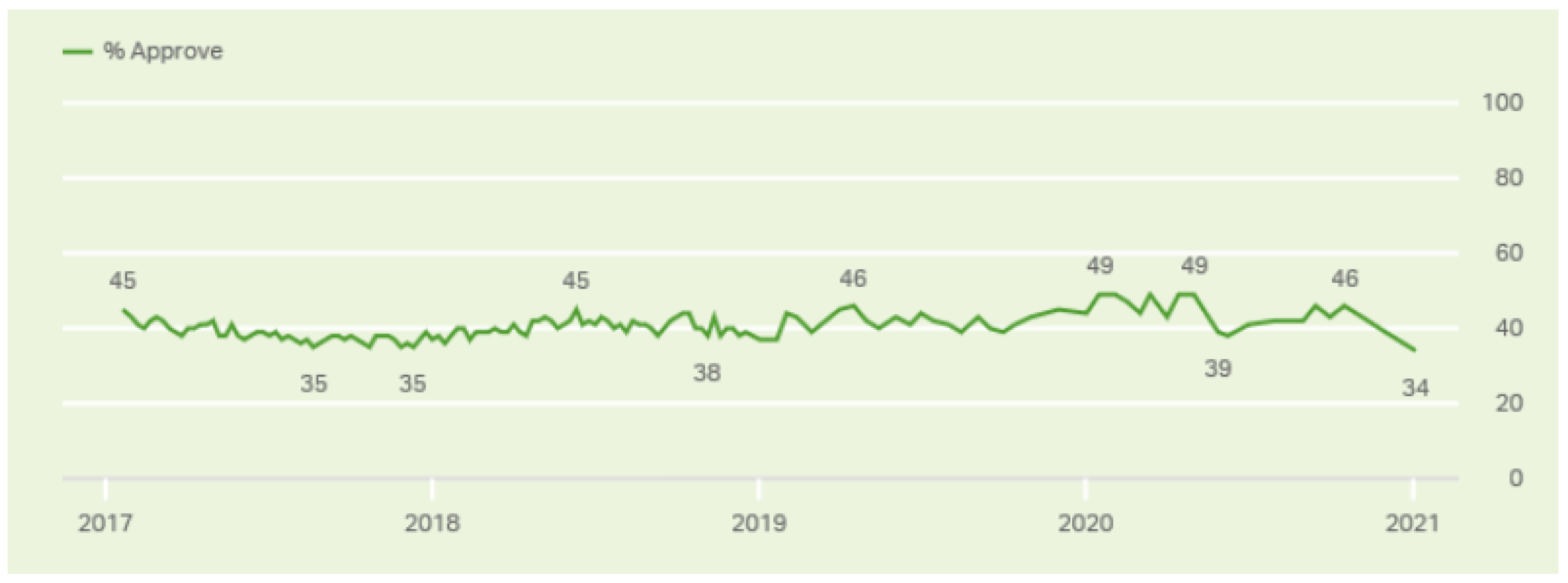
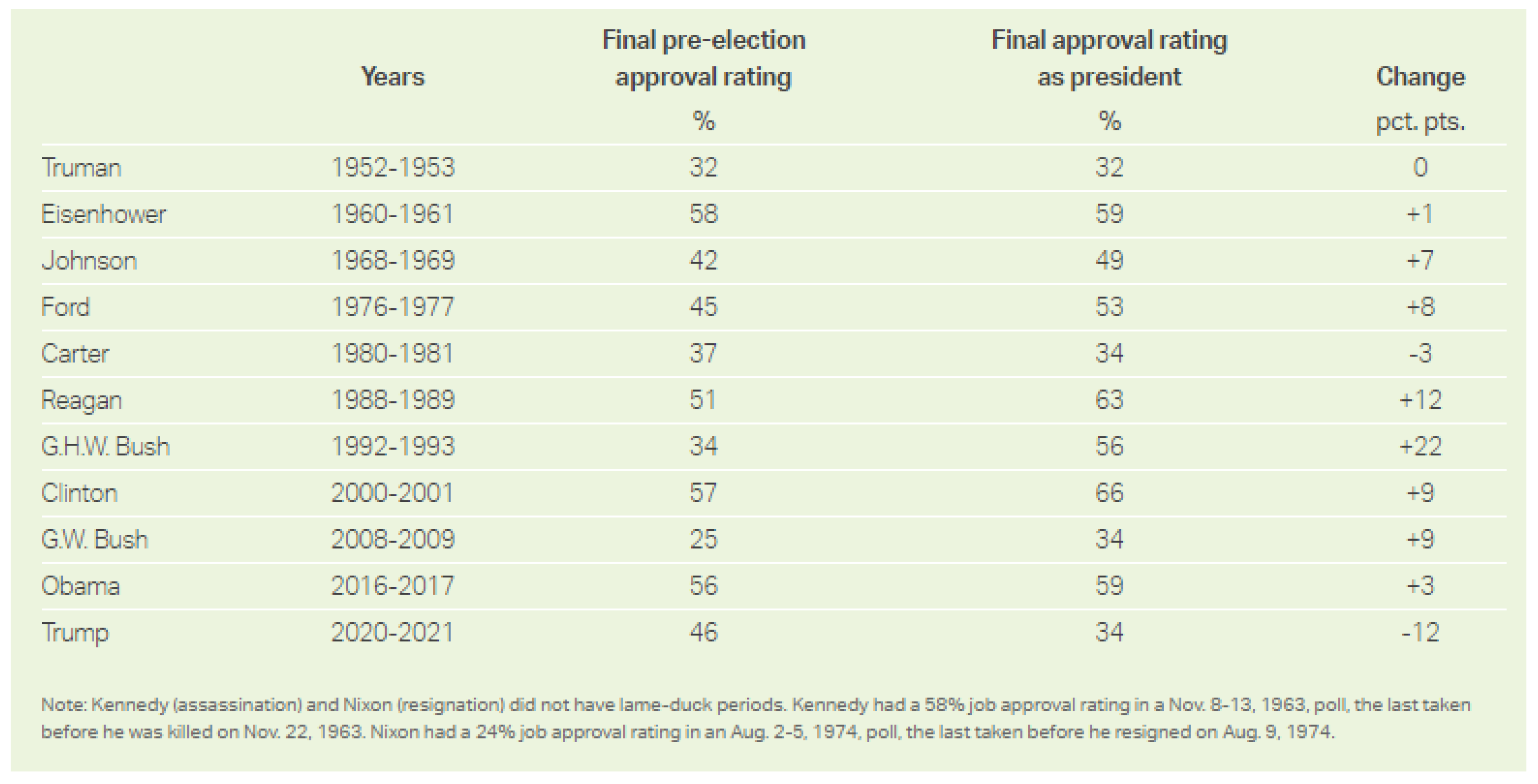
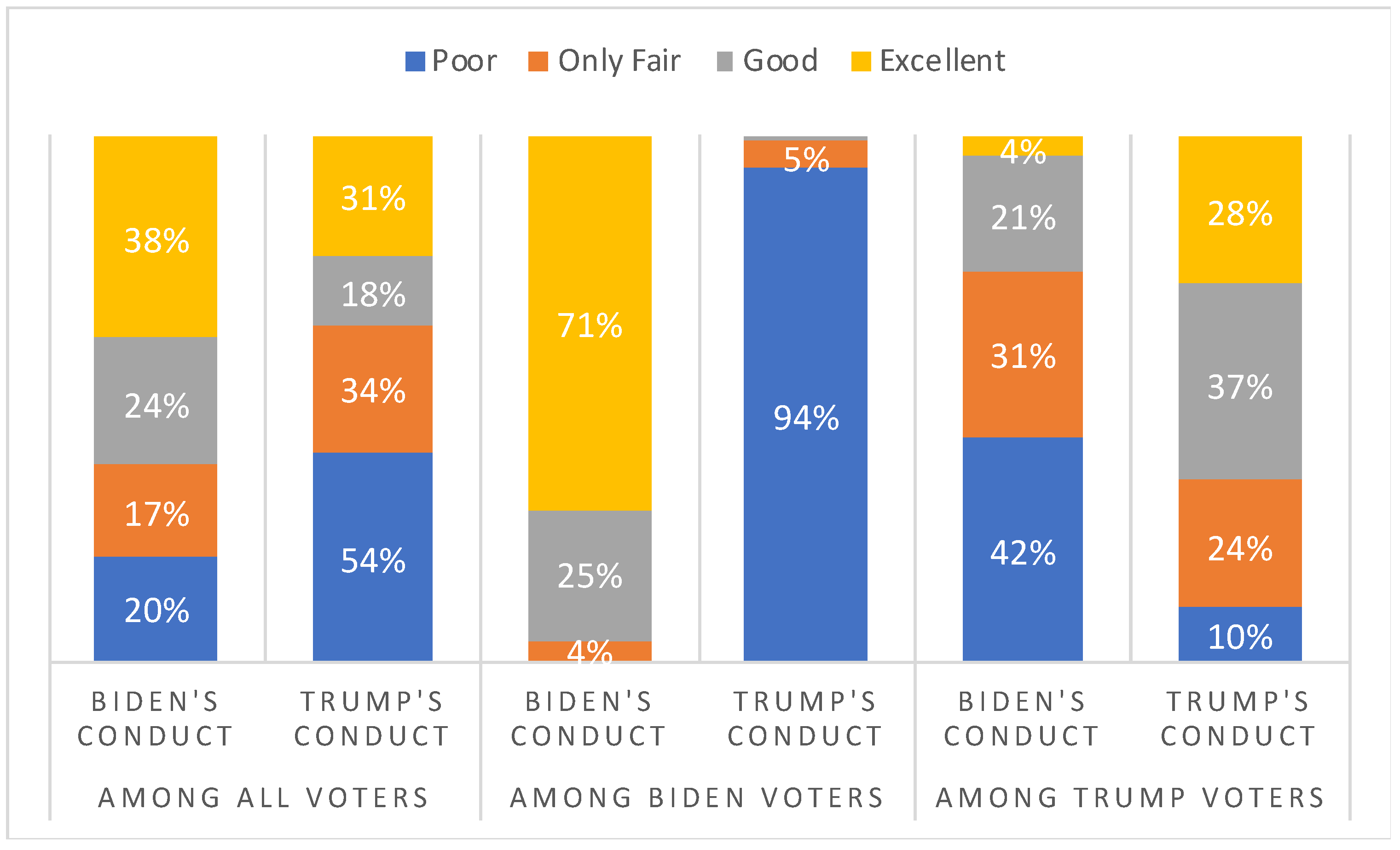
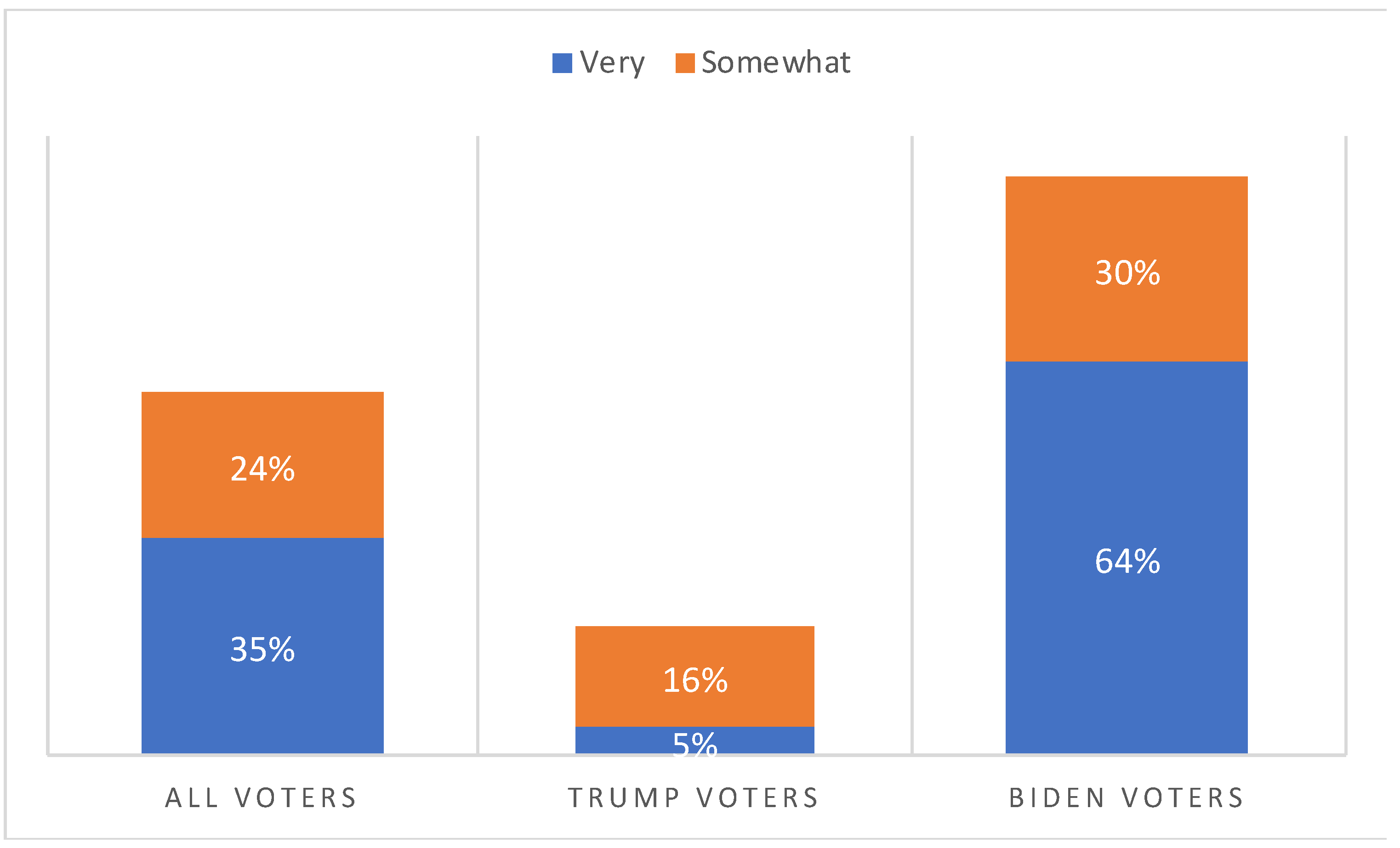

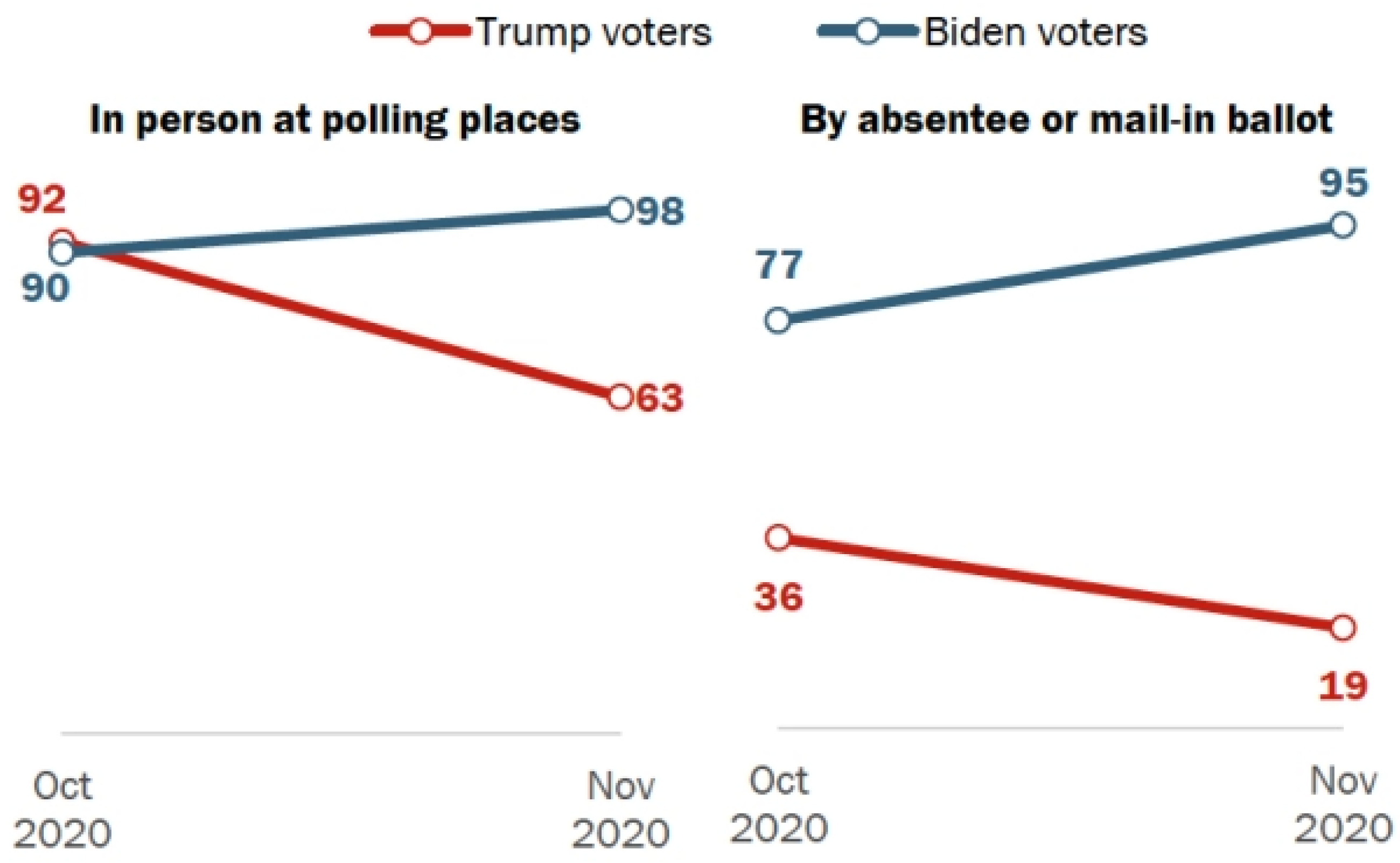
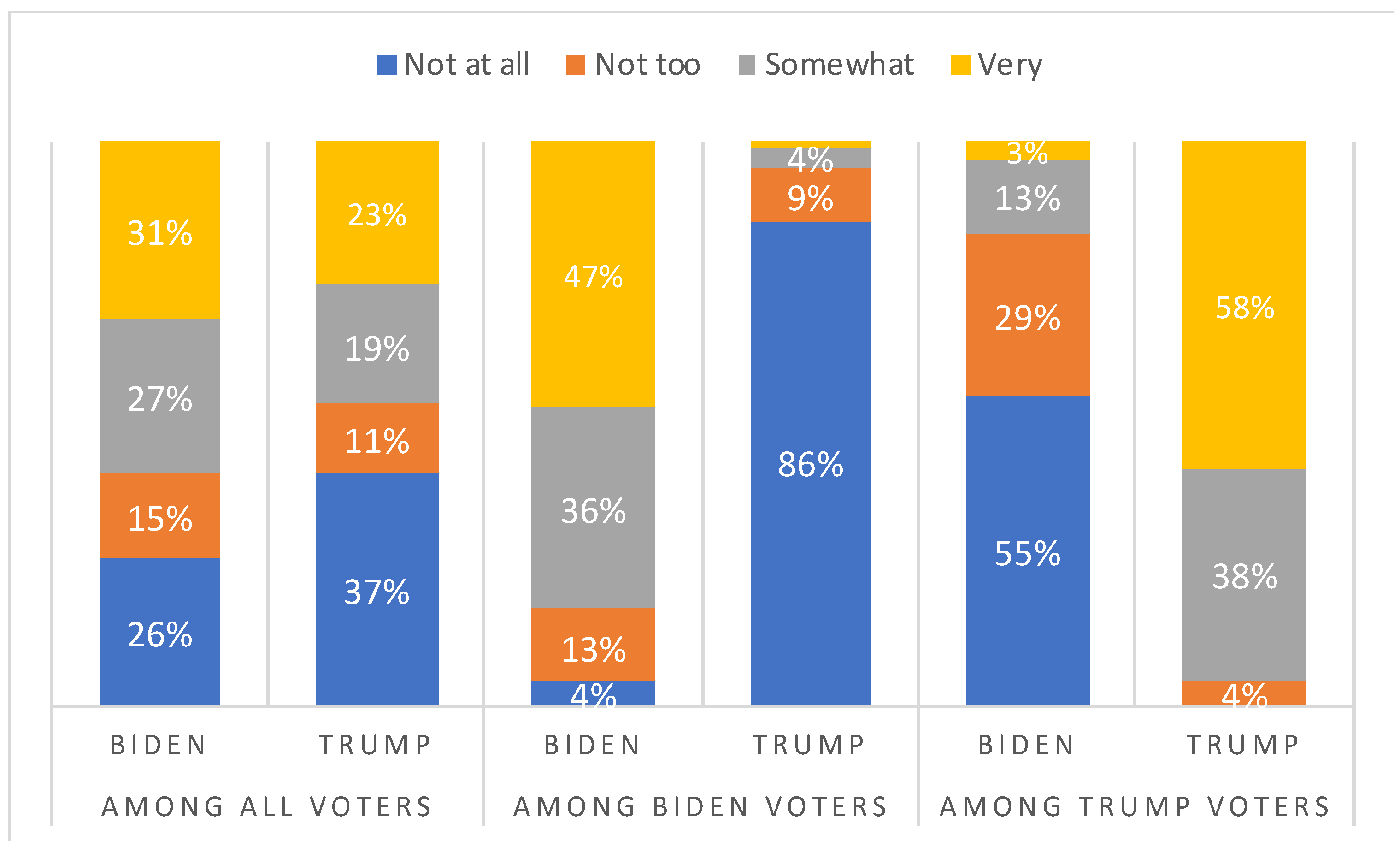
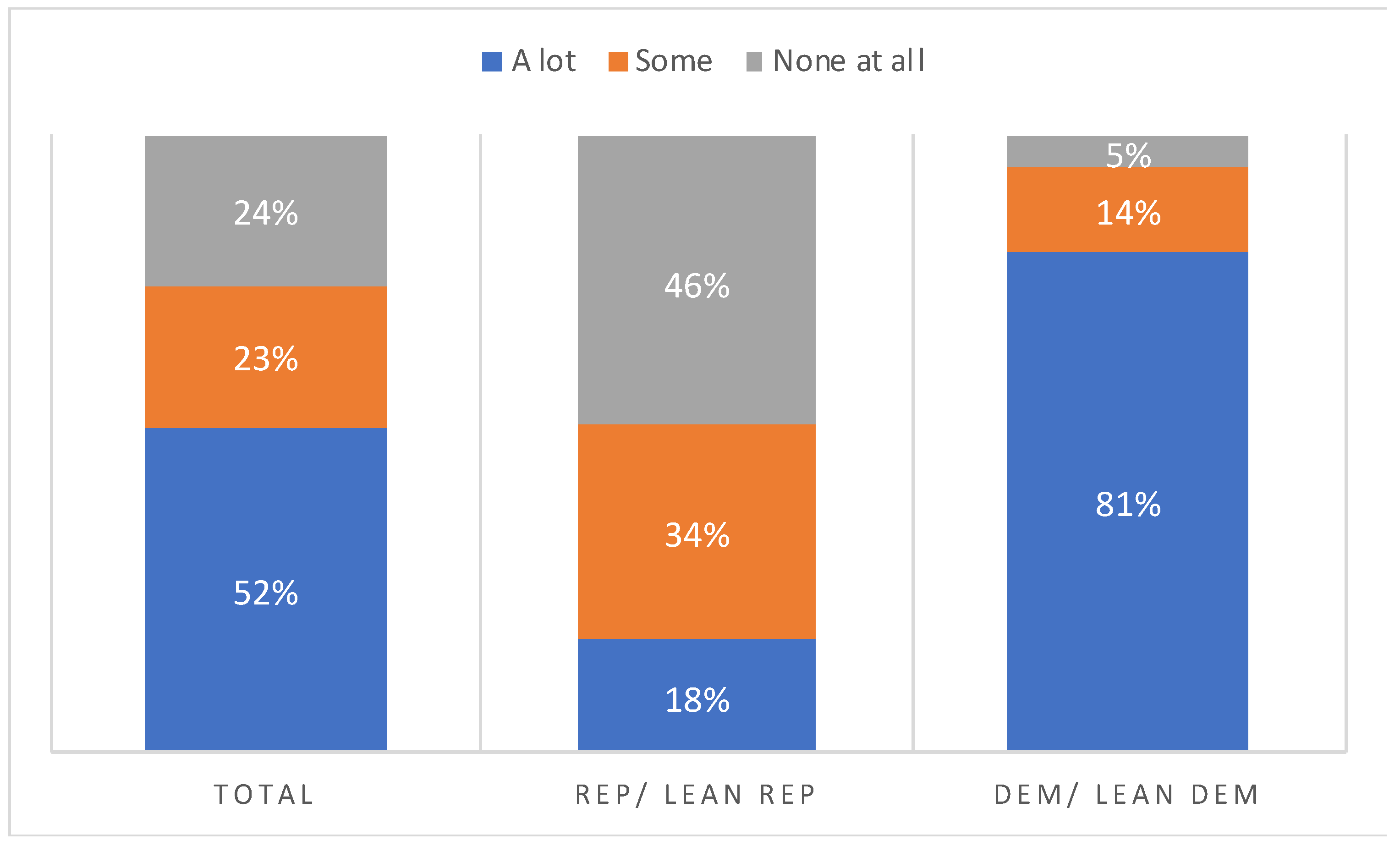
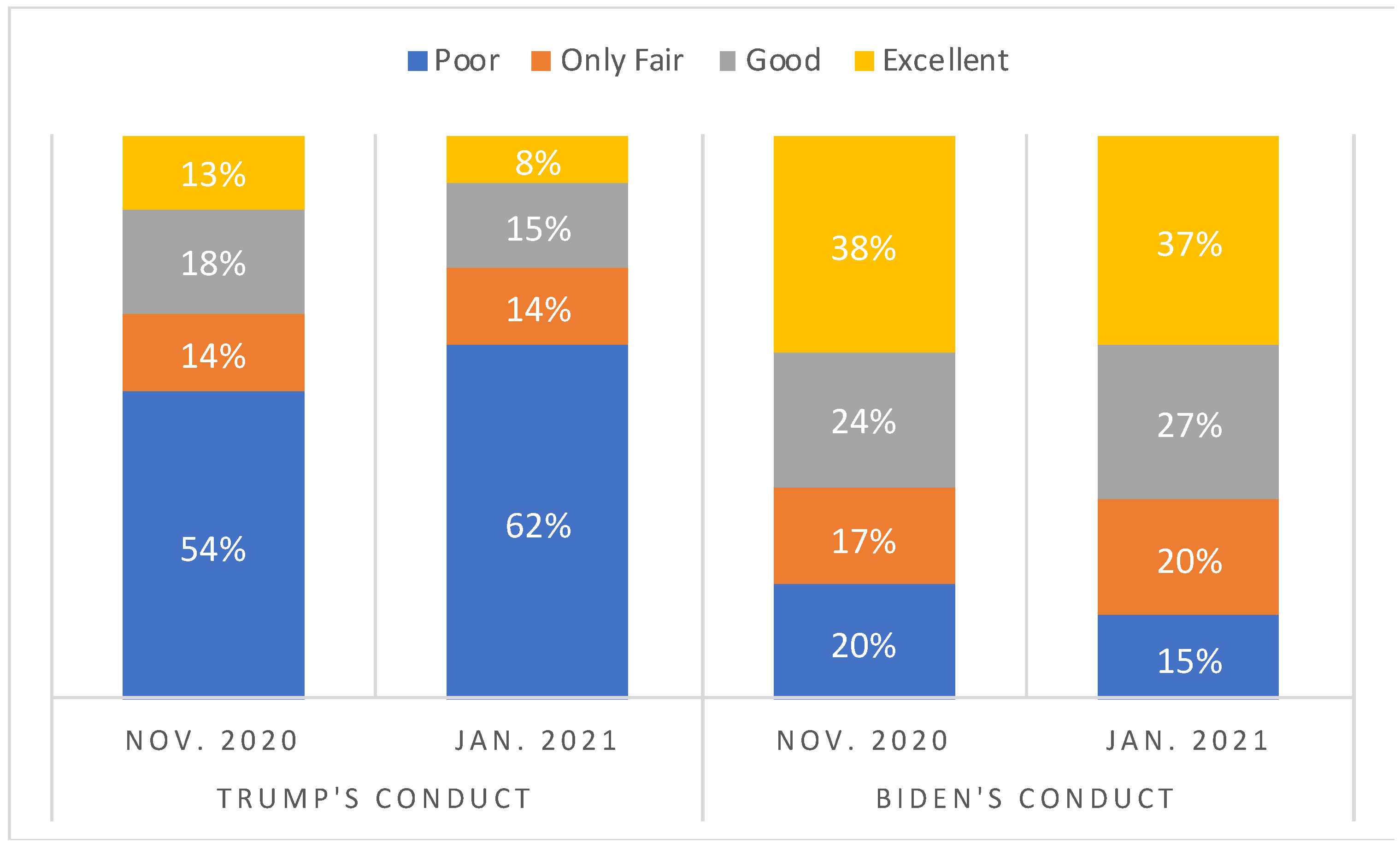

| Research Questions | American Trend Panel 2020 | American Trend Panel 2021 | |
|---|---|---|---|
| RQ1 | What have been the causes of the loss of confidence in Trump manifested by a segment of the American electorate after the US election? | Figure 3. Trump and Biden’s post-election conduct evaluation Figure 7. Trust in the candidates’ ability to manage the COVID-19 health crisis. | Figure 9. Evolution of the evaluation of Trump’s and Biden’s behavior after the presidential election |
| RQ2 | How do voters view Trump’s populist strategy in the post-election phase? | Figure 4. Percentage of voters who believe that the U.S. elections have been well managed Figure 5. Percentage of voters who are convinced that their vote has been counted correctly | Figure 10. Percentage of Americans who incorrectly think Trump won the election |
| RQ3 | How have Trump’s fraud speech and the incidents of the Capitol attack influenced the changing attitudes of the American electorate? | Figure 6. Evolution of trust in the correct recounting of the vote | Figure 8. Citizens who consider that Trump bears at least part of the responsibility for the Capitol disturbances |
Publisher’s Note: MDPI stays neutral with regard to jurisdictional claims in published maps and institutional affiliations. |
© 2021 by the authors. Licensee MDPI, Basel, Switzerland. This article is an open access article distributed under the terms and conditions of the Creative Commons Attribution (CC BY) license (https://creativecommons.org/licenses/by/4.0/).
Share and Cite
Pérez-Curiel, C.; Domínguez-García, R.; Jiménez-Marín, G. Public Sphere and Misinformation in the U.S. Election: Trump’s Audience and Populism Indicators in the COVID-19 Context. Journal. Media 2021, 2, 335-350. https://doi.org/10.3390/journalmedia2030020
Pérez-Curiel C, Domínguez-García R, Jiménez-Marín G. Public Sphere and Misinformation in the U.S. Election: Trump’s Audience and Populism Indicators in the COVID-19 Context. Journalism and Media. 2021; 2(3):335-350. https://doi.org/10.3390/journalmedia2030020
Chicago/Turabian StylePérez-Curiel, Concha, Ricardo Domínguez-García, and Gloria Jiménez-Marín. 2021. "Public Sphere and Misinformation in the U.S. Election: Trump’s Audience and Populism Indicators in the COVID-19 Context" Journalism and Media 2, no. 3: 335-350. https://doi.org/10.3390/journalmedia2030020
APA StylePérez-Curiel, C., Domínguez-García, R., & Jiménez-Marín, G. (2021). Public Sphere and Misinformation in the U.S. Election: Trump’s Audience and Populism Indicators in the COVID-19 Context. Journalism and Media, 2(3), 335-350. https://doi.org/10.3390/journalmedia2030020








